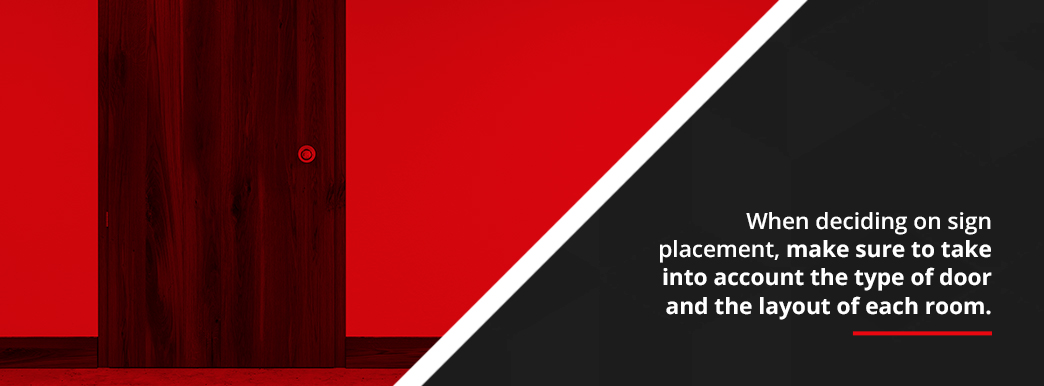
ADA Sign Mounting Instructions
APRIL 13, 2020| SpeedProThe Americans with Disabilities Act (ADA) is designed to remove barriers to people with disabilities. Most places with public access, from hotels, stores and restaurants to commercial buildings, hospitals and warehouses, need ADA building signage. After you’ve worked with your sign printer to create signs that meet ADA regulations, the next step is to mount them in designated locations.
Where you place a sign must follow ADA guidelines. Tactile signs should be low enough to the floor that someone can reach them without standing up, but not so low that someone might have to bend over. Signs should be visible at a reasonable distance. So, place them in an area where they will be well lit and unobstructed.
Types of ADA Signage
There are four basic types of ADA signs, each with different rules about placement.
- Identification signs: The most basic type of ADA sign, these signs identify a distinct zone or room within a building. For example, the bathroom, stairwell or human resources department may each be labeled. These signs belong next to doorways.
- Informational signs: Informational signs give further context to identification signs. They do not name the room, but offer information such as “Members Only,” or “Smoking Area.” These signs should also be placed next to doors.
- Wayfinding or directional signs: These signs point out locations to help people navigate. They may state things like, “Rooms 11 through 40 this way.” These signs might not be placed close to doors, as they direct people throughout a building. They can be placed in hallways or en route to the area they lead visitors toward.
- Overhead signs: Signs that hang from ceilings or are mounted to the wall 80 inches above the ground are considered overhead signs. They may have directional or informational signage. The information on the sign will indicate whether it should be placed above a doorway or in a hallway.
Where Do I Hang ADA Signage?
When hanging identification and informational signs, place them near the doors to that area. While there is no regulation on the distance between the sign and the door itself, it’s best to keep the sign 2 to 3 inches from the door frame. You’ll place wayfinding signs along the route to the destination. For these types of signs, you’ll need to hang them at least 48 inches above the floor, and 60 inches above the ground at the highest. It’s best to center them at 54 inches.
Overhead signs are a little different and will be hung from the ceiling or on a wall at least 80 inches above the floor.
Before you hang a sign, make sure it will be visible. The ADA lists regulations for doorway signage in Section 703 of its guidelines. It should be well lit and should not be impeded by the swing of any door. Where you mount ADA room signage depends on the kind of door you are using and the design of the room:
- One door: Attach the sign to the latch side of a single door.
- Double door with one active leaf: Affix the tactile sign to the inactive panel.
- Double door with two active leaves: Hang the sign to the right side of the right-hand door.
- Inward swinging doors: On the push side of a double or single swinging door, you may place tactile signs directly on the door. Only do this if the entry has automatic closers and no hold-open devices. Common doors that meet these criteria are kitchen and bathroom doors.
- Elevator doors: Section 407 of the ADA guidelines give instructions for where to place signage next to elevators. Signs indicating floor numbers should be hung on each side of an elevator door. If there are multiple cars, then each car will need to be labeled on both sides as well. These signs should be placed directly on the jambs of the doorways.
- No wall space: You may only place signs on doors themselves if they meet specific criteria. If there is no room to mount the sign on the latch side of a single door or to the right of a double door, you can hang the sign on the nearest adjacent wall.
- Floor space: A tactile sign must be positioned so that a person can read it by touch. To meet ADA regulations, measure a clear floor space 18 inches by 18 inches and center the sign’s tactile characters at the 9-inch mark. Account for the arc swing of an outward swinging door when designating this floor space. The 18-by-18 inch box should be completely clear when the door is in any position between closed and opened to 45 degrees. If you do not have enough space to center a sign with an 18 by 18 square, then hang the sign on the nearest adjacent wall.
Step-by-Step Guide to ADA Sign Mounting
Follow these steps to mount your ADA signage.
1. Gather Your Tools
You’ll need a pencil, a tape measure and a level. The sign itself will come with a foam tape adhesive strip. Extra-heavy signs may need a silicone adhesive.
2. Know Where to Hang the Sign
When you are hanging signage throughout your building, it may be helpful to mark a floor plan with each sign location. When deciding on sign placement, make sure to take into account the type of door and the layout of each room.
Signs that have raised tactile characters, as well as Braille, must be placed 48 inches above the floor. A visual sign that has no Braille must be placed 40 inches from the floor or higher.
3. Clean the Wall
To ensure the sign adhesive sticks to the wall, first, clean the wall to remove dust and debris.
4. Take Measurements
First, measure where to place the sign relative to the door. Remember to stay above 48 inches and below 60 inches. Measure the minimum height from the baseline of the lowest line of tactile characters, and the maximum height from the baseline of the highest line of tactile characters.
Since the recommended height is about 54 inches centered, mark this height with your pencil. Or, if you choose to center the sign at another point, mark that center point instead.
Next, measure the sign itself and divide that number in two. This figure is the halfway point of your sign. For a sign with a height of 4 inches and a length of 5 inches, its halfway point will be 2 inches vertically and 2.5 inches horizontally.
5. Center the Sign
To center the sign, vertically, measure up to the halfway mark, then subtract the vertical halfway point from this number. In our example of a 4-inch tall sign centered at 54 inches, this means subtracting two from 54 to get 52. So, make another mark at 52 inches from the floor.
Remember that the sign should be centered within the 18-by-18 inch box of floor space to ensure that the raised lettering and Braille can be read by touch. Once you’ve found your box, measure this 18-inch length along the 54-inch mark, and make a mark at 9 inches. Then, subtract the halfway point from 9 inches and make a mark. For a sign that is 5 inches long, you should make a mark at 2.5 inches subtracted from 9 inches, or 6.5 inches.
6. Place the Sign
To place the sign, attach the adhesive backing to the sign. Then, align your sign with the centering marks you’ve just made. Place the left edge of your sign on the mark to the left of center, and the bottom edge on the mark below center.
After you’ve found the right placement, use a level to ensure the sign is straight. Then, apply the sign to the wall and press firmly.
Get ADA Signs With SpeedPro
Your local SpeedPro studio can create ADA-approved signs and help you place them throughout your building. With an on-site analysis, you’ll receive a professional examination of your building’s wall space, door radius, floor-to-ceiling heights and more to help you hang signs in the appropriate location.
With the help of your SpeedPro team, you can be sure that your building is welcoming and open to all visitors.


















